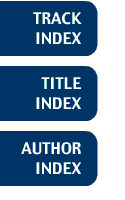
Track: Water Resources
GIS Vector and Raster Database, Advanced Geostatistics, Three-Dimensional Groundwater Flow, and Transport Modeling in Strongly Heterogeneous Geologic Media: An Integrated Approach

Mahmoud BouzelboudjenFrancesco KIMMEIER
The aquifers of the Rhone Valley in Switzerland are of great economic importance. The groundwaters related to the Rhone can easily be reached and therefore are exploitable at slight cost. However, their situation in generally narrow valleys with human activity make them especially vulnerable in regard to quality as well as to quantity. Since 1995, the State of Valais has decided to integrate the data of numerous local studies into a more regional hydrogeological context. The aim is to build a three-dimensional hydrogeological model describing the geometry of aquifers and aquitards, their lithologies, and their hydrodynamical characteristics (permeability, porosity, and storage coefficient) as well as the hydrochemical parameters. We employed ArcInfo-ArcView GIS as the geographic information system and the Oracle-Access database management system on the workstation and personal computer. The advanced geostatistical treatment of spatial basic data (stationary, nonstationary, and simulation methods) relative to the geometry of the aquifer system is carried through several software (Surfer, Isatis, and ArcInfo). New piezometers allowed in a certain way the control of the reliability of the geostatistical analysis results and show the importance of the interpolator in the rebuilding of the different structural layers. The geostatistical approach is applied also for physical parameter fields of aquifer according to the depth and the hydrochemical parameters. These stages are important for the definition of three-dimensional boundaries' model conditions. Once the geostatistical analysis was carried out, linking from a regular network to the irregular finite elements grid constituting the model network requires the implementation of specific interfaces. Presently, ArcInfo-ArcView GIS and Oracle-Access database allow to preserve and to manage the different information levels in two-dimensional maps and profiles. The drawing up of automatic sections for multilayer systems provides an easy checking of the three-dimensional geometry of the hydrogeological model. The first model used is a three-dimensional mathematical "quadratic" finite elements model developed at the Centre of Hydrogeology of Neuchatel (Fen Codes). The second model used is a three-dimensional mathematical finite elements model developed by Wasy GmbH (Feflow). The integration of new data in the GIS will ensure control of the coherence of the groundwater flow system representation.
Mahmoud Bouzelboudjen
University of Neuchatel
Emile-Argand 11
Neuchatel, 2007
NEUCHATEL
Telephone: +41 32 718 26 88
Fax: +41 38 718 26 01
E-mail: Mahmoud.bouzelboudjen@chyn.unine.ch